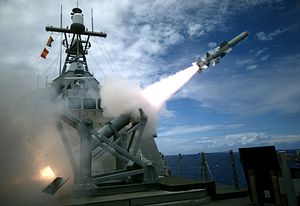Speaking at an Army symposium last week, U.S. Pacific Command head Admiral Harry Harris revealed that the U.S. Army and the Japanese Ground Self Defense Force will sink a target ship (SINKEX) with shore-based anti-ship cruise missiles (ASCM) at next year’s Rim of the Pacific Exercise (RIMPAC). Since at least last year, U.S. officials have advocated for ground forces to develop an anti-ship capability as part of the Multi-Domain Battle concept as a way to utilize services other than the U.S. Navy to exert sea-control in a hypothetical clash in the Western Pacific.
RIMPAC is the world’s largest multinational naval exercise, held every two years in the waters around Hawaii. The exercise in 2016 involved forces from 26 countries, including 45 ships, 200 aircraft, and over 25,000 personnel. That exercise showcased the first test of a Harpoon anti-ship cruise missile fired from a Littoral Combat Ship (though the missile failed to hit its target), and reinvigorated a logistics capability to sustain fuel supplies to the fleet at-sea. Expanding the lethality of the Navy’s surface fleet and giving the fleet’s fuel supplies greater range and sustainability are crucial capabilities for a potential clash with the growing Chinese fleet in the Western Pacific where the U.S. may find its traditional fuel logistics hubs under threat from long-range Chinese missiles.
Next year’s SINKEX represents a stunningly fast turnaround for developing a new capability for the U.S. Army since Admiral Harris and then-Undersecretary of the Navy Janine Davidson publicly advocated last year to “get the army to sink a ship.”
The U.S. Army will be firing the Naval Strike Missile (NSM), a multi-purpose, subsonic cruise missile designed by Norway’s Kongsberg and built in partnership with Raytheon. While subsonic, the missile is low-observable and maneuverable. With a range of just over 100 nautical miles, it has greater reach than the U.S. Navy’s aging Harpoon anti-ship missiles, but far less than advanced Chinese supersonic anti-ship cruise missiles like the YJ-18, which the U.S. Department of Defense assesses may have a range of nearly 290 nautical miles (though other analysts place the range closer to 120 nautical miles).
By selecting the NSM to test, Pacific Command has reduced the development and training burden leading up to next summer’s exercise as Kongsberg already produces a truck-mounted coastal defense version of the NSM for the Polish Navy. The Japanese Ground Self Defense Force already fields the Type 12 ASCM, a truck-mounted, subsonic missile with a range just over 120 nautical miles, and is developing an improved ASCM with a range of at least 180 nautical miles.
Admiral Harris said that creating an expeditionary anti-ship capability in the U.S. Army helps “address some of the tough problems that we face together in archipelagic defense scenarios.” Integrating such a capability with those of allies and partners like Japan is equally significant. Unspoken in Admiral Harris’ invocation of “archipelagic defense scenarios” is that these capabilities are being developed to deal with a potential clash with China.
Japan was motivated to develop its new, extended-range coastal defense ASCM to supplement its defenses on the Senkaku islands in the East China Sea. China also claims the Senkakus, which it calls the Diaoyu islands, as its territory and regularly challenges Japanese administration of the islands with maritime incursions by its fishing fleet, maritime militia, and coast guard.
The Senkakus in the East China Sea make up part of the first island chain, which stretches from the Japanese Home Islands south through the Philippine archipelago and surround nearly China’s entire coastline. The United States has also repeatedly affirmed that it will defend the Senkakus from attack under the terms of its defense treaty with Japan. The treaty is thus one of the ways that the United States could be drawn into such an archipelagic defense scenario against China.
A Congressionally-commissioned study of a future fleet and operational concepts for the Navy by the Center for Strategic and Budgetary Assessments released this year described how similar anti-ship capabilities could be used not just to defend against, but to contain an adversary. In the study’s example, expeditionary ground units (this case used U.S. Marines, but could just as plausibly be ASCM-equipped U.S. Army units) equipped with coastal defense ASCMs and air defenses positioned on Japan’s Southwest islands (which include the Ryukyus and Senkakus) could “contain an adversary’s power projection capabilities.” The relatively close proximity of the Southwestern islands to eachother means that batteries of land-based ASCMs, especially in concert with naval and aviation support, could effectively keep China’s North Sea and East Sea fleets bottled up inside the first island chain, unable to break out into the wider Western Pacific.
As I wrote about the Multi-Domain Battle concept last year, the ability to contain China within the first island chain using land-power projected towards the sea provides the United States and its allies with a deployable Anti-Access/Area Denial (A2/AD) capability of its own. Western focus is often on how China’s A2/AD shield of sensors, long-range missiles, fleets, and aircraft would challenge the United States’ ability to conduct operations within the first island chain.
With next year’s SINKEX, the United States will be that much closer to being able to turn the tables and challenge China’s own ability to conduct operations in and beyond the first island chain. Notably, it was recently announced that China will be invited to participate in next year’s RIMPAC as well, where it will see this ground-based anti-ship capability demonstrated firsthand. Once those capabilities are mature, mutual recognition of each country’s ability to stymie the other from conducting offensive operations within the chain could help deter either from trying.

































